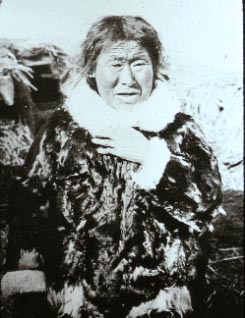
 |
| Inuit Woman |
The materials on this page are intended for use by students enrolled in ANTH 329 North American Indians. This page and its references are periodically up-dated.
Reading Assignments
Gill 1982: 42-45 and 122-124, and review 83-112
Oswalt and Neely 1999:107-142
Suggested Videos
Nanook of the North, Home Vision Cinema, and The Living Stone, National Canadian Film Board.
Overview
The primary focus of this section will be on the Kuskowagamiut, a Yupik people of Alaska and the Arctic culture area. Additional references will also be made to the Inuit peoples. The term, Eskimo, has also been used generically to identify both the Inuit and Yupik peoples, but it is generally not what the native peoples of the arctic region prefer to call themselves. The term "Eskimo" is a Cree word, often translated as "eaters of the flesh." "Inuit" means the "people," and is derived from the plural form of the word "inua," meaning "soul" or "spirit."
The Arctic culture area extends the length of some 6,000 miles of arctic coast, from the Alaskan Panhandle and Aleutian Islands in the west along the northern coastal lands of Canada to Baffinland and Labrador to the southern and eastern coastlines of Greenland in the east.
The Inuit and Yupik peoples lived a nomadic, transhumance life, gaining their subsistence off the seal and walrus, the caribou and various fish, and alternating their mode of travel by kayak and umiak during the summer, and by dog-sled during the winter. While living in a rather harsh and unpredictable environment with a limited technology, these peoples obtained a reliant and viable lifeway by relying on a intricate knowledge of their land and on the spiritual insights of their shamans. The Inuit and Yupik are biologically distinct from the neighboring Indian populations, forming their own racial category.
In April of 1999, the Territory of Nunavut was established for the Inuit peoples, culminating several years of negotiation with the Canadian government. The Territory represents over 20% of the Canadian land-mass, and two-thirds of Canada's coast line. While functioning within the Canadian government, not unlike other provinces, and comprising over 85 percent Inuit peoples, Nunavut has a certain degree of the political self-governance, seeking collective recognition of the Inuit peoples, including the protection of traditional cultures and lifestyles, and aboriginal rights, as well as economic rights to lands and resources. Nunavut represents an attempt by an indigenous people to re-establish a base for their own economic self-sufficiency and development, and political and cultural sovereignty.
Self-Study Guide Questions
You are currently viewing http://www.uidaho.edu/~rfrey/arctic1.htm
To return to Frey's Home Page
To return to the Department of Sociology,
Anthropology and Justice Studies
To return to the University of Idaho Home Page
Page manager:rfrey@uidaho.edu